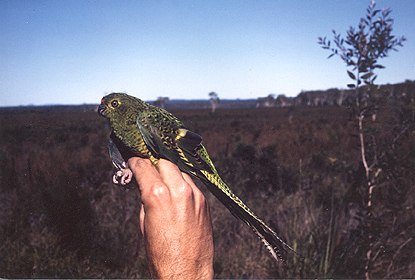- Ground Parrot
Taxobox
name = Ground Parrot

image_width = 300px
status = LC | status_system = IUCN3.1
regnum =Animal ia
phylum = Chordata
classis = Aves
ordo =Psittaciformes
familia =Psittacidae
subfamilia =Psittacinae
tribus =Pezoporini
genus = "Pezoporus "
species = "P. wallicus"
binomial = "Pezoporus wallicus"
binomial_authority = Kerr, 1792The Ground Parrot ("Pezoporus wallicus") is one of only four ground-dwelling parrots in the world, the others being its closest relative, the extremely rareNight Parrot , the somewhat closely relatedAntipodes Island Parakeet , and the unrelated highlyendangered kakapo fromNew Zealand .The coloration of these birds - except the Antipodes species - is similar, yellowish-green with darker barring, somewhat reminiscent of the head and back of the wild-type
budgerigar . This is not an indication of true relationships, however, but either adaptation to a particular lifestyle or a feature retained from ancestral parrots; probably the latter as barred plumage is found all over the family, from the tiny tiger parrots to femalecockatiel s.When disturbed, it flies swiftly just above the ground before dropping back into the vegetation again.
The presence of the bird is often only revealed by its characteristic dusk and dawn call, a clear, whistling sequence of notes which rise in pitch before fading. It is silent in flight.
There are 3 subspecies of the Ground Parrot.
The
Tasmanian Ground Parrot is least endangered, and is most common in south west TasmaniaThe Eastern Ground Parrot occurs in fragmented populations near the coast in southern
Queensland ,New South Wales and Victoria and is considered vulnerable on the schedules of the NSWThreatened Species Conservation Act .There are estimated to be 4000 breeding birds The ground parrot was one of only two parrot species recorded in
Sydney before 1900, and both of them (theTurquoise Parrot is the other) are now listed as 'vulnerable' under the New South Wales Threatened Species Conservation Act. Neither species is found within 100 km of Sydney today. It has become extinct inSouth Australia .The Western Ground Parrot is fourth on the list of the rare parrots of mainland Australia. It is Western Australia's most endangered endemic parrot. Although the
Night Parrot has been recorded fromWestern Australia , it was not restricted to WA.Ground Parrot ("Pezoporus w. wallicus") (Kerr 1792)
Description
Up to 30 cm long. Plumage grass green, each feather with black and yellow markings; narrow orange-red band to forehead; head, nape, upper back and breast green, each feather with black shaft marking; feathers of abdomen, thighs and under tail-coverts greenish-yellow with black barring; under wing-coverts green; primary coverts green; flight-feathers green with pale stripe across them; underside of flight-feathers with pale yellow wing-stripe; upperside of tail-feathers green with yellowish striped markings, underside brownish; outer tail-feathers yellow with brownish-black striping; bill greyish-brown to horn-colour; cere greyish-pink; narrow periophthalmic ring pale grey; iris whitish-yellow; longish feet greyish-brown; claws not so curved as other parrots.
Immatures as adults, but with slightly duller plumage; orange-red band to forehead absent; head, nape, upper back and breast green, each feather with distinct black shaft markings; tail shorter; iris brown.
Distribution
Extreme southeast of Queensland to southwest Australia ( scattered in small groups); Tasmania and some off-shore islands.
Western Ground Parrot "(Pezoporus wallicus flaviventris)" (North 1911)
Description
The western subspecies is similar to "wallicus", but feathers of abdomen and under tail-coverts pale yellow with indistinct black barring.
Distribution
Coastal areas of western southwest
Australia from Perth north toGeraldton and along the South Coast east to Israelite Bay.Habitat
Marshy coastal plain without trees, reed beds with low bushes, restricted to
button grass areas; species may depend on naturally occurring fires allowing new growth and renewed settlement by the Ground Parrot.tatus
Only found in certain localities and endangered throughout; especially threatened by cultivation of large coastal areas, but also foxes, cats and fire; alleged to have strong scent and therefore easily disturbed by dogs.
Habits
A solitary shy and during daylight silent parrot perfect camouflaged by plumage; if disturbed runs away rather than fly, then lands again short distance away; flight characterised by loud, whirring wingbeats and erratic with short gliding phases; this calling period also occurs early in morning; variable high-pitched call audible for some distance; answered by neighbouring members of species; probably local seasonal migrations.
Diet
Seeds of various grasses, especially
button grass ("Mesomelaena sphaerocephala ").Breeding
Breeding period from September to January; (one record in March); nest consisted of an excavation in soil 15 cm to 18 cm across and 2 cm (0.75 ins) to 5 cm deep; usually well hidden under small bush or tussock hanging over nest to provide a form of hollow; mostly lined with leaves, grass stalks, fern and small twigs; clutch 3 to 4 eggs; incubation probably 21 days; chicks well camouflaged with thick greyish-black down and protected against cold periods; young remain in nest for two weeks approaching parents for food; fed three times daily; leave nest after three weeks at least disturbance; roost after 25 days outside under tussocks; cannot however fly at this point; egg measures 28.1 x 22.2 mm.
External links
* [http://birdswa.iinet.net.au/projects/wgp/wgp.htm Western Ground Parrot Project]
Wikimedia Foundation. 2010.
